While businesses are eagerly awaiting the unification of foreign exchange rates, the head of the Tehran Chamber of Commerce, Industries, Mines and Agriculture says conditions are rife for the long-awaited unification plan to finally become reality.
"Considering the status of oil revenues and a relative stability in the foreign exchange market, the best possible circumstances have presented themselves and there is no more room for hesitation when it comes to the unification of forex rates," Masoud Khansari was quoted as saying by khabaronline.ir news website.
Oil prices which have fallen by more than half since 2014 due to overproduction regained some ground in the wake of OPEC member states agreeing this week in Algiers to finally cap production levels.
"The existence of an official rate that is different from the real rate in the open market can only be justified under extremely rare circumstances, such as war," Khansari added.
Single currency rates are a crucial requirement for the reintegration of Iran into the global banking system and payment networks. Iran was forced to revert to the controversial double exchange rate regime after international sanctions unleashed chaos in the forex market in 2011-12 in which the national currency, the rial, lost almost 70% of its value within days.
Brave New World
For Iran's economy to be able to compete in local and international markets, says the TCCIMA head, "it must once and for all embrace floating rates."
As to any other major conditions needed for implementing the currency unification plan, Khansari said no special conditions are required. "Actually it is the process of interfering with forex rates and employing a dual rate system that requires unique circumstances," he added. "Like any other commodity, forex rates must be allowed to float and endure in the market based on the mechanism of supply and demand."
Referring to the recent policy of the Central Bank of Iran allowing commercial banks to trade in the parallel foreign exchange market and efforts undertaken to minimize the discrepancy between official and unofficial forex rates, he expressed the hope that the government will soon be able to unify the rates.
"What has so far impeded the process is government procrastination and concerns about possible tensions."
Forex rate unification has for long been a hot-button issue in economic debates , with the CBI governor Valiollah Seif repeatedly heralding the implementation of the plan by the end of the current fiscal year in March 2017.
In his latest remarks, the minister of economy also stressed that the forex rates will certainly be unified by the yearend. "The government is adamant on unifying the rates," said Ali Tayyebnia, adding, "The scheme will be implemented by the end of the current year.
The CBI managed to unify forex rates back in March 1993, when foreign currencies were traded at 12 different rates. The provision proved short-lived with single rates being halted after seven months. The CBI employed a single rate regime once again in 2002-03, which also failed to produce the desired results.


